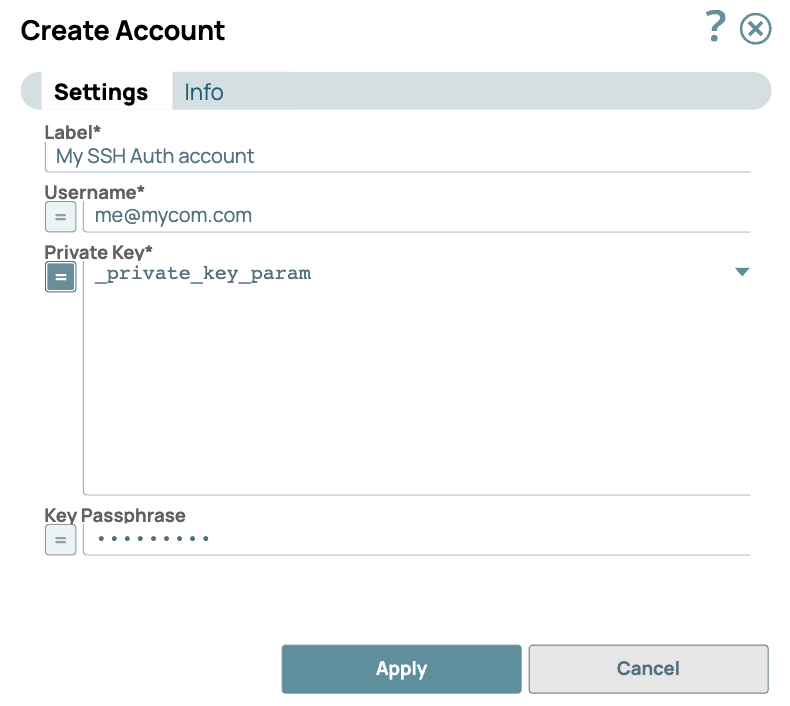SSH Auth Account
- RSA
ssh-rsa, header-----BEGIN RSA PRIVATE KEY-----…-----END RSA PRIVATE KEY----- -
DSA
ssh-dsa, header-----BEGIN DSA PRIVATE KEY-----…-----END DSA PRIVATE KEY----- -
ECDSA
ecdsa-*, header:-----BEGIN EC PRIVATE KEY-----…-----END EC PRIVATE KEY----- -
EdDSA
ssh-ed25519andssh-ed448, header:-----BEGIN OPENSSH PRIVATE KEY-----…-----END OPENSSH PRIVATE KEY-----
We recommend that you use EdDSA for modern systems where both the client and server support it, since it offers better security. RSA with larger key sizes like 2048 and 4096 offers good security while being compatible with older systems.
Account Settings

- Expression icon (
): Allows using JavaScript syntax to access SnapLogic Expressions to set field values dynamically (if enabled). If disabled, you can provide a static value. Learn more.
- SnapGPT (
): Generates SnapLogic Expressions based on natural language using SnapGPT. Learn more.
- Suggestion icon (
): Populates a list of values dynamically based on your Snap configuration. You can select only one attribute at a time using the icon. Type into the field if it supports a comma-separated list of values.
- Upload
 : Uploads files. Learn more.
: Uploads files. Learn more.
| Field / Field set | Type | Description |
|---|---|---|
| Label | String |
Required. Specify a unique label for the account. Default value: N/A Example: SSH Account |
| Username | String/Expression | Required. Specify the Account username or use the
Expression enabler to select the appropriate value. Default value: N/A Example: Snap Admin |
| Private Key | String/Expression | Required. Specify the private key for SSH
authentication. Ensure that the private key is with header and footer. This is a
multi-line field that allows you to copy paste the private key along with its
header and footer. Warning: For an SSH account, you must generate a
public/private key for snapuser on the Groundplex, add the private key and
username to the SSH account settings in SnapLogic, add public key to the sftp
machine for that user. The Private key must be enclosed within the BEGIN RSA
PRIVATE Key and END RSA PRIVATE KEY, as shown below:----BEGIN RSA PRIVATE
KEY-----MIIEoQIBAAKCAQEAnTFVYHy6A3YeJbrJ7MY/uiRZViiTLBf8AGo5WDCWLkmkwP2hl/jFBAwZLR4k6Tz6wOLuo1w+y6+DyCgNrgiJdpnJXlbGfX8J/wUdDliNOTS0+LukWYTcTroTA==-----END
RSA PRIVATE KEY-----
Default value: N/A Example: Default Value: N/A Example: ----BEGIN RSA PRIVATE KEY----- MIIEoQIBAAKCAQEAnTFVYHy6A3YeJbrJ7MY/uiRZ ViiTLBf8AGo5WDCWLkmkwP2h l/jFBAwZLR4k6Tz6wOLuo1w+y6+DyCgNrgiJdpnJ XlbGfX8J/wUdDliNOTS0+LukWYTcTroTA== -----END RSA PRIVATE KEY----- |
| Key passphrase | String/Expression | Specify the passphrase to decrypt the private key. Default value: N/A Example: dfdkJ*KM0245,-K24= |
Account Encryption
| Standard Encryption | If you use Standard Encryption, the High sensitivity settings under Enhanced Encryption are used. |
| Enhanced Encryption | If the account you are using has the Enhanced Encryption feature, the account
fields are encrypted for each sensitivity level as shown below:
|
Refer to : Generating SSH Key Using PuTTY Key Generator


